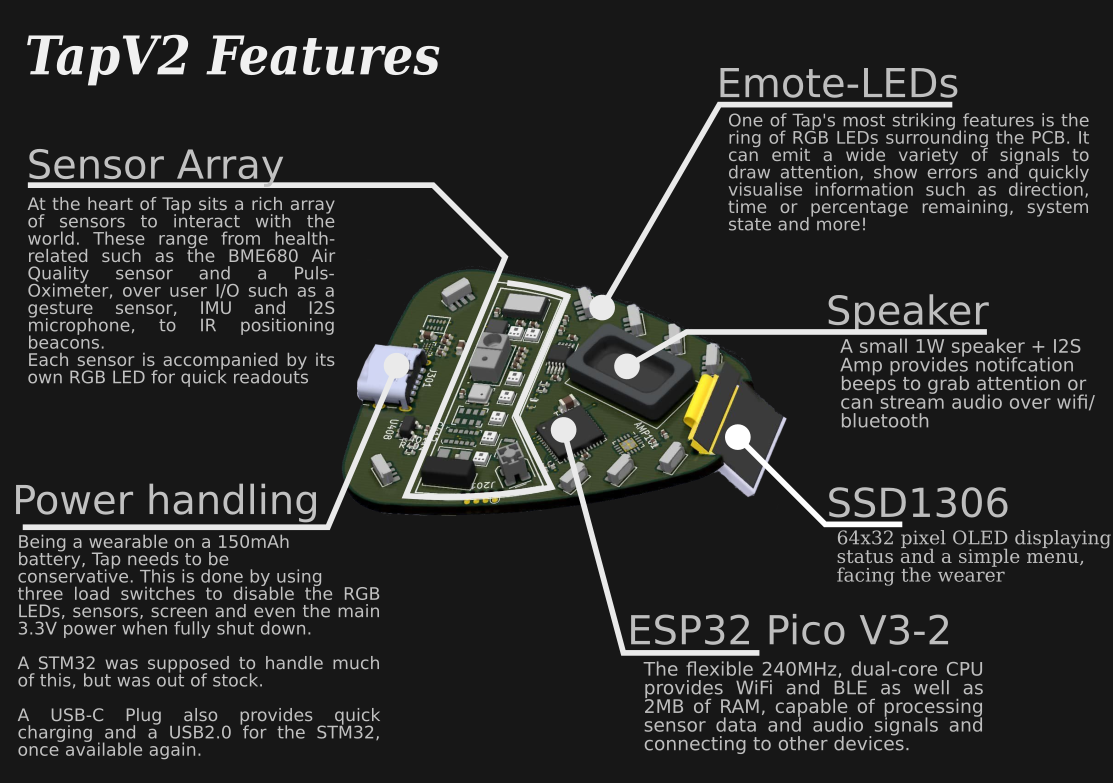No time? At least look at the intro video:
And a demo of one of the sensors, the gyroscope:
https://twitter.com/XasinTheSystem/status/1453095741501620230
Or a demo of the tap and twist input methods!
https://twitter.com/XasinTheSystem/status/1455661802298150916
And a little debate timer, a first practical use case:
https://twitter.com/XasinTheSystem/status/1460379972506423305
But what even is this?

And a casing:

This project is meant as a sort of... "Everything controller"
We have a lot of projects with a lot of things to configure - RGB colour schemes, patterns, sounds, or other settings - and we love networking and linking these things up even more!
We could, of course, give every system a clean interface...
But that is not our way. What is more fun is, of course, to build an interface device that can connect to, and control, as many devices as possible. Make it compact, give it a tiny screen, tons of LEDs, StarTrek aesthetic, a few oddball input methods - and you have Tap!
With its current set of connections, it can theoretically do a lot. The ESP32 Pico can handle BLE and WiFi as sender or receiver, the IR LED can act as a TV remote control, and the microphone and speaker can talk to humans or act as an intercom!
Implementing this is the challenge I am currently facing. The hardware has proven itself to work, now the code needs to be cleaned up, polished, and made to run.
Part of my motivation for Tap is also, how I like to describe it, a passion and "challenge" project.
It is born as a remake of a former project, #Tap to control, utilizing all the shiny new knowledge we gained over the last couple of years.
Its design was specifically chosen because it features challenging or new aspects.
This was the first four-layer board I designed, with 0402 components, in a space-constrained, somewhat thin enclosure. It has a limited battery to deal with and should work over BLE.
All of these things offered new experiences to play and grow with and gave us a lot of opportunities to learn already.
The coding will also involve some fascinating things such as power gating options to conserve as much as possible, handle a BLE connection, and provide a natural and hopefully easy-to-use gesture- or tapping-based user interface.
It'll be useful too, don't worry!
This project isn't just an exercise in over-the-top board design, extra-fancy LEDs or sound effects. It'll have many very useful real-world applications that will mesh well with other projects such as #The dragon's home
It'll serve as locating beacon using IR signals to improve the quality of our room light, it can act as a pedometer and has a Pulse-Oximeter to help with staying active. The integrated BME680 is also a wonderful air quality monitor to tell you when to open the window!
The lights at the top of the badge serve to fetch your attention when it has a message to send to you, and the screen and speaker combo can either show you or speak out, any textual information - things like live feeds from other projects, or a shopping list when you're in the supermarket that you sent over on the computer.
The screen could even plot graphs or show a small map to help you navigate!
The (future) gesture sensor and gyro provide a limited but easy to use interface, enough to navigate basic menus and thusly configure room lights or interact with other connected items, and the ESP32 Pico provides many interfaces to do so, ranging from raw TCP/UDP over MQTT to BLE connections.
Lastly, the speaker and microphone can be used as a StarTrek-Like communicator or Bluetooth headset. Yes, there is a reason the badge looks like this ;)
Sounds great, when will it do all this?
Well, we are getting there!
Currently, the hardware is almost fully functional. Only a few ICs are missing due to the component shortage, but all of the main features are running nicely.
What is being worked on now is the code. Setting up a clean basis to add functionality is key to making a project that can be with us for years, adapt and grow to fit new ideas as we need it.
Right now, the hardware layer and a first basic menu system for the OLED screen are being written, to provide clean interfaces for things such as the screen, gesture recognition, and LED outputs.
Everything by itself is quite doable, though there simply is a lot of it, requiring careful and patient attention to polish everything to the best it can be.
Still - lots left to do, to explore and experiment with!
 Xasin
Xasin